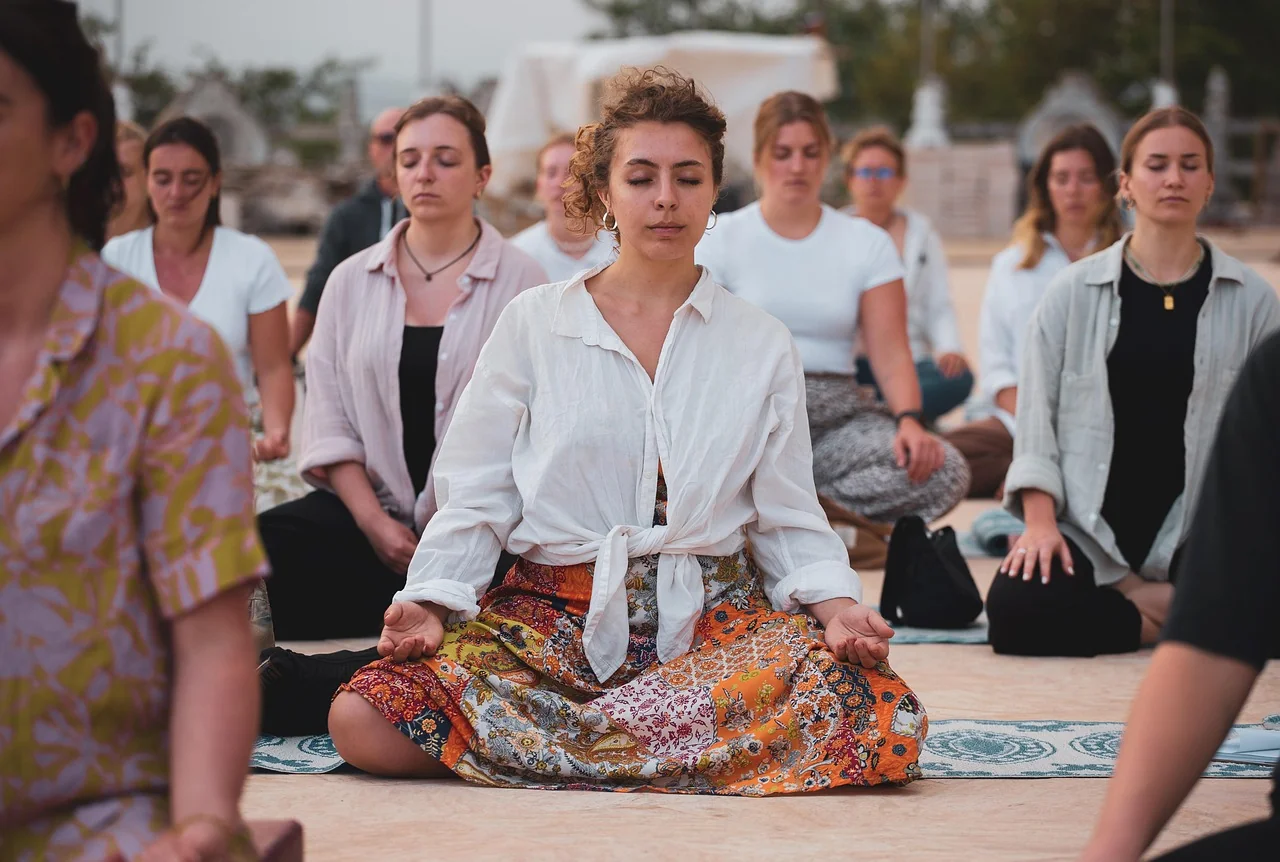Have you ever had a gut feeling so strong you couldn't ignore it—a sudden knowing about a person or decision without any logical explanation? That’s your intuition, your inner wisdom, trying to cut through the noise of daily life. But with constant distractions, that quiet voice often gets drowned out. This is where a guided meditation for intuition becomes your most powerful tool. It’s a dedicated practice to quiet your busy mind, creating the silent space necessary for your deepest insights to finally surface.
In this comprehensive guide, we’ll demystify the science behind your "sixth sense" and explore the profound benefits, from sharper decision-making to reduced anxiety. You’ll learn exactly how to prepare for your practice and receive a step-by-step framework to begin confidently accessing the profound guidance that has been within you all along. Let's embark on a journey to turn down the volume of the world and turn up the volume of your own inner voice.
What is Intuition and How Guided Meditation Can Unlock It
Intuition is often described as a gut feeling, a quiet knowing, or a sudden flash of insight. It’s your subconscious mind processing vast amounts of information, patterns, and experiences at lightning speed, presenting you with an answer long before your logical brain has finished its analysis. Think of it as your internal GPS, always running in the background, guiding you toward what truly serves you and away from potential harm.
So, why is this powerful voice so often a whisper? Modern life is a symphony of distractions—endless to-do lists, digital notifications, and internal chatter. This constant noise creates a low-grade static that muffles your intuitive signals. You might get a subtle nudge, but it’s easily rationalized away or ignored entirely.
This is precisely where a guided meditation for intuition offers a direct solution. Unlike silent meditation, where you might get lost in your thoughts, a guided session provides a structured pathway. A skilled guide uses verbal cues to lead you into a deeply relaxed state, systematically quieting the analytical parts of your brain. This process is like lowering the volume on a crowded, noisy room so you can finally hear the person whispering in the corner. By following the guide, your conscious mind has a job to do, which allows your subconscious—the home of your inner wisdom—to come forward. It’s a practice of creating the perfect internal conditions to develop your intuition consistently and reliably.
The Science and Benefits: Why Cultivating Your Intuition Matters
While intuition can feel mystical, science is beginning to understand its biological underpinnings. Brain imaging studies show that during meditation, the prefrontal cortex—the brain's center for analytical thinking and judgment—becomes less active. This "quieting of the CEO" allows other regions, like the insula and the anterior cingulate cortex, to communicate more freely. These areas are linked to interoception (sensing internal bodily signals) and gut feelings. In essence, meditation doesn't create intuition; it removes the mental blockades that prevent you from perceiving it.
Committing to a regular intuitive meditation practice unlocks a cascade of tangible benefits that extend far beyond a single "aha!" moment.
- Improved Decision-Making: When you learn to access inner wisdom, you make choices that are more aligned with your core values and long-term well-being. You move from overthinking and analysis-paralysis to a place of confident knowing, saving time and mental energy.
- Enhanced Creativity and Problem-Solving: Your subconscious mind is a vast repository of interconnected ideas. By tapping into it, you can find novel solutions to complex problems and unlock creative flows you didn't know you possessed. Artists, writers, and innovators often cite intuition as their primary muse.
- Reduced Anxiety and Stress: A strong connection to your intuition fosters a deep-seated trust in yourself and your path. You spend less time second-guessing your choices and worrying about the future because you have an internal compass you can rely on. This leads to a significant reduction in anxiety.
- Deeper Self-Connection and Clarity: This practice is a direct line to your authentic self. It helps you cut through societal expectations and conditioned responses to understand what you truly want and need. This self-awareness is the foundation of a purposeful and fulfilling life.
The benefits of intuitive meditation are profound because you are not learning a new skill, but rather remembering and honing an innate human ability.
Preparing for Your Practice: A Foundation for Deeper Listening
Setting the stage for your meditation is just as important as the practice itself. A little preparation signals to your mind and body that it’s time to shift gears from doing to listening, creating a container that supports a deeper experience.
Creating Your Sanctuary
You don’t need a dedicated meditation room, but a consistent, comfortable space is ideal. Choose a quiet corner where you are unlikely to be interrupted. You might add a comfortable cushion or chair, a soft blanket, or dim lighting. The goal is to create an environment that feels safe, peaceful, and separate from your daily hustle.
The Best Time to Practice
There is no universally "perfect" time, but many find that practicing first thing in the morning, when the mind is still fresh from sleep and free from the day's clutter, is highly effective. A guided meditation morning routine can set a calm, centered tone for your entire day. Alternatively, practicing before bed can help you process the day and receive insights through your dreams. Experiment to find what works best for you, but consistency is key.
Posture for Receptivity
The ideal posture is one that is both relaxed and alert. You can sit cross-legged on a cushion, sit upright in a chair with your feet flat on the floor, or even lie down if you’re confident you won’t fall asleep. The important thing is that your spine is relatively straight to facilitate energy flow and prevent drowsiness, but your body is not held with rigid tension.
Setting a Simple Intention
Before you begin, take a moment to set a gentle, open-ended intention. This primes your subconscious mind for the work ahead. Your intention shouldn’t be a demand, but an invitation. Examples include:
- "I am open and receptive to the messages of my heart."
- "I allow my inner wisdom to speak to me clearly."
- "I trust the feelings and insights that arise." This simple act of setting an intention for meditation for inner guidance focuses your energy and directs your awareness inward.
A Step-by-Step Guide to Your First Guided Meditation for Intuition
This sample script is a framework you can follow on your own. Read it through first to familiarize yourself with the journey, then you can record it in your own voice or simply recall the steps as you meditate.
Step 1: Settling Into Your Space Find your comfortable, alert posture. Gently close your eyes. Bring your awareness to the physical sensations of your body. Feel the weight of your body on the chair or cushion. Notice the points of contact—your feet on the floor, your hands resting on your legs. Without trying to change anything, simply observe.
Step 2: Connecting with the Breath Now, draw your attention to your natural breath. Don’t force it; just follow the rhythm of your inhalation and exhalation. Feel the cool air entering your nostrils and the slightly warmer air leaving. Notice your chest and belly gently rising and falling. Use the breath as an anchor to the present moment. Spend 1-2 minutes here, allowing the mind to settle.
Step 3: A Body Scan for Full Presence Slowly guide your awareness through your body. Start with the toes... noticing any sensations there, and consciously allowing them to relax. Move to the soles of your feet, your ankles, and your calves... releasing any tension. Continue this journey up through your knees, thighs, and hips... feeling a wave of relaxation. Move through your abdomen, lower back, and chest... letting go of the need to hold or control. Relax your shoulders, down through your arms and into your hands and fingers. Finally, bring relaxation to your neck, jaw, face, and the space between your eyebrows. Feel your entire body present, heavy, and at ease.
Step 4: Journey to Your Heart Center Now, bring your focused awareness to the center of your chest, the area of your heart. Imagine a soft, warm, glowing light residing there. This is your heart center, a place of deep knowing and compassion. With each inhale, imagine that light growing brighter and warmer. With each exhale, imagine that light expanding to fill your entire chest cavity. Rest your awareness here.
Step 5: Posing a Question and Listening From this place of open-hearted awareness, gently introduce a simple, open-ended question. It should not be a "yes or no" question, but one that invites feeling. Examples are: "What do I need to know right now for my highest good?" or "Where should I direct my energy?". Ask the question once, softly, as if whispering it into your own heart. Then, stop. Let go of the question completely. Shift your entire focus to listening. Do not try to think of an answer. Instead, become a receptive vessel. Pay attention to whatever arises:
- A single word or short phrase that pops into your mind.
- A sudden wave of emotion (peace, joy, unease).
- A visual symbol or memory.
- A physical sensation in your body. Trust the very first thing that comes. Avoid analyzing or judging it.
Step 6: Expressing Gratitude and Returning Whatever you experienced—or even if you experienced nothing but stillness—thank your inner self for showing up. Acknowledge the act of listening itself. Then, gently begin to bring your awareness back to your breath. Wiggle your fingers and toes. Slowly and gently, open your eyes, bringing the sense of calm and connection back with you into the room.
Integrating Intuitive Insights into Daily Life
The true power of this practice is realized when you bring it off the cushion and into your world. An insight during meditation is a seed; you must plant it in the soil of your daily life for it to grow.
Keep an Intuition Journal: Immediately after your meditation, jot down anything you experienced—words, feelings, images, or even the simple quality of the silence. Over time, you will see patterns and build a vocabulary for your unique intuitive language. This also helps you validate your intuition when a feeling later proves to be accurate.
Start Small and Build Trust: Begin by using your intuition for low-stakes decisions. Which route should I take to work? What should I have for lunch? Notice the subtle pull and follow it. Each time you act on a gut feeling and it works out, you strengthen your trust in this inner faculty.
Distinguish Intuition from Fear: This is a crucial skill. Intuition typically feels calm, clear, and neutral, even when delivering a warning. It’s a "knowing." Fear, on the other hand, is often frantic, emotionally charged, and filled with catastrophic "what if" scenarios. Intuition feels like a quiet whisper; fear feels like a blaring alarm. Your journal will help you learn to tell the difference.
Create Mindful Check-Ins: Several times throughout your day, pause for just 10 seconds. Take one conscious breath and drop into your heart. Ask, "What is my intuition saying about this moment?" This builds the habit of checking in with yourself amidst the busyness of life.
Deepening Your Practice: Next Steps on Your Journey
Once you have established a consistent foundation, you can explore more advanced techniques to further refine your connection.
Explore Different Meditation Styles: Try chakra meditations, focusing specifically on the Third Eye chakra (for insight) and the Heart chakra (for compassionate knowing). Loving-kindness meditations can also powerfully open the heart and clear emotional blocks to intuition. You can also explore a meditation for silence to further cultivate the inner quiet necessary for intuition to flourish.
Incorporate Oracle Cards: For some, a tangible tool like an oracle card deck can provide a helpful focus. Instead of using them for fortune-telling, use a single card pull as a meditation prompt. Ask, "What energy do I need to connect with today?" and meditate on the card's imagery and message to see what personal insights arise.
Join a Group or Find a Teacher: Practicing with a community or under the guidance of an experienced teacher can provide support, new perspectives, and deeper accountability. They can offer personalized feedback that can help you overcome specific hurdles.
Your intuition is a loyal and wise companion that has been with you your entire life. Through the dedicated practice of guided meditation for intuition, you are simply learning to sit down, be quiet, and finally listen to the friend who has always been whispering the way. This is not a destination, but a lifelong journey of coming home to yourself, one quiet moment at a time.
In closing, unlocking your intuition is not an esoteric mystery but a practical skill honed through consistent practice. This journey into guided meditation for intuition has illuminated the simple yet profound steps to quiet the conscious mind and access the subtle wisdom within. By creating a dedicated space, engaging in regular sessions focused on breath and body awareness, and learning to trust the gentle impressions that arise, you cultivate a powerful inner compass. This practice transforms intuition from a fleeting guess into a reliable guide for navigating life's complexities with greater clarity and confidence. The true power lies not in a single session, but in the cumulative effect of making this practice a part of your life. Begin today by finding a quiet moment to listen within; your inner wisdom is ready to speak, offering the guidance you seek to live a more aligned and purposeful existence.


